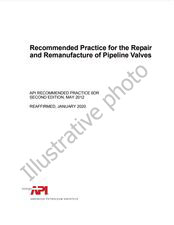We need your consent to use the individual data so that you can see information about your interests, among other things. Click "OK" to give your consent.

API RP 65-1-ed.2
Cementing Shallow-water Flow Zones in Deepwater Wells
Translate name
STANDARD published on 1.6.2018
The information about the standard:
Designation standards: API RP 65-1-ed.2
Publication date standards: 1.6.2018
SKU: NS-1140218
The number of pages: 71
Approximate weight : 213 g (0.47 lbs)
Country: American technical standard
Category: Technical standards API
Annotation of standard text API RP 65-1-ed.2 :
API RP 65-1, 2nd Edition, June 2018 - Cementing Shallow-water Flow Zones in Deepwater Wells
Overview
This standard describes practices designed to prevent shallow-water flow (SWF) during and following the cementing of wells located in deepwater. It is the compilation of technology and practices developed and used by many operators around the world. Although most of the discussion in this standard is focused on SWF, shallow flows can be mixtures of water, gas, gas hydrates, and formation fines. There is no single method of preventing shallow-water flow, and many of the activities described may require customization to fit individual well conditions. While this standard is extensive, it is not meant to limit innovation and new technology.
The content of this document is not all inclusive, and guidance from other sources may apply. Note that this standard is not meant to be a stand-alone training manual or well design standard.
Although fairly comprehensive, there are still many details that are not discussed and that should be addressed when drilling and cementing wells in deepwater. It is meant to highlight key parameters for increasing the chance of successfully drilling and cementing casings where there is a risk of shallowwater flow and to discuss options that are available. More details can be gleaned from the references listed in the bibliography. Most of the information in this document is from U.S. Gulf of Mexico experience. The concepts can be applied in other deepwater environments with appropriate modifications. The user should consult experts within the industry for specific details of the cementing process relating to the technology being used by a specific company for a specific scenario. The construction of the casings through the SWF zones should be a team effort to be successful. All parties involved shall participate in the planning and execution of all phases of the process to ensure successful construction of the conductor and surface casings.
In this standard, where practical, U.S. customary units (USC) are included in parentheses for information. The units do not necessarily represent a direct conversion of metric units (SI) to USC units, or USC to SI. Consideration has been given to the precision of the instrument making the measurement. For example, thermometers are typically marked in one-degree increments; thus, temperature values have been rounded to the nearest degree.
Objective
The objective of this standard is to communicate methods to prevent shallow-water flows in the tophole sections of deepwater wells during and after cementing operations.
Conditions of Applicability
This document is applicable to the following well conditions:
- — tophole section(s) of the well;
- — shallow hazard assessment concludes a risk/potential for shallow flow.
This does not include isolating potential flow zones beyond the tophole section(s) of the well; see API Standard 65-2.
Background
SWF are water flows from permeable formations at shallow depths below the mudline in wells drilled in deep ocean waters. The water flows can compromise the structural or hydraulic integrity, or both, of the tophole section(s). The tophole section is a part of the well often drilled without a marine riser where drilling and cementing fluids exit the well annulus at the seafloor. SWF can occur in sections drilled with a riser where fluid returns are at the rig. Modes of failure include:
- — poor isolation by cement resulting in casing buckling/shear;
- — pressure communication to other shallow formations, causing them to be overpressured;
- — disturbance of the seafloor due to breakthrough of the shallow flow to the mudline.
NOTE Such damage can result in the complete loss of drilling templates containing previously cased wells.
Flows from these shallow formations are typically a result of abnormally high pore pressure in undercompacted and usually unconsolidated sediments formed in a rapid depositional environment. Not all flows are the result of these naturally developed formation geopressures. Other causes for abnormal shallow pressures include hydraulic communication from deeper, higher-pressure formations, tectonic uplift, and induced storage during drilling, casing, and cementing operations.
Flow of sediments results in hole enlargement, which can increase the rate of flow and make it more difficult to control. The enlargement may also cause caving of formations above the flow interval. The flow of water and formation material from these zones can result in damage to the wells, including foundation failure, formation compaction, damaged casing (wear and buckling), re-entry and control problems, sea floor craters, mounds, and crevasses (R.M. Ostermeier et al. 2000, Eaton, L.F. 1999). Flow channels through or around the cement sheath may be formed as a result of one or more of the following:
- — poorly designed or executed primary cementing;
- — flow occurring due to dilution or channeling while the cement is being placed;
- — flow occurring after the cement slurry is placed, but before it has attained a structure sufficient to prevent formation fluid flow, will create channels through which flow can continue;
- — poor hole conditions.
Geopressure can be transmitted through channels in the cement sheath and, if trapped by a seal (mechanical isolation), can charge or fracture a formation of lower pressure
We recommend:
Technical standards updating
Do you want to make sure you use only the valid technical standards?
We can offer you a solution which will provide you a monthly overview concerning the updating of standards which you use.
Would you like to know more? Look at this page.



 Cookies
Cookies
